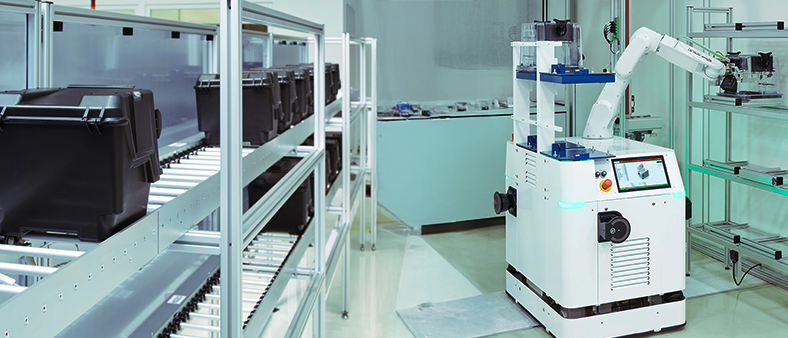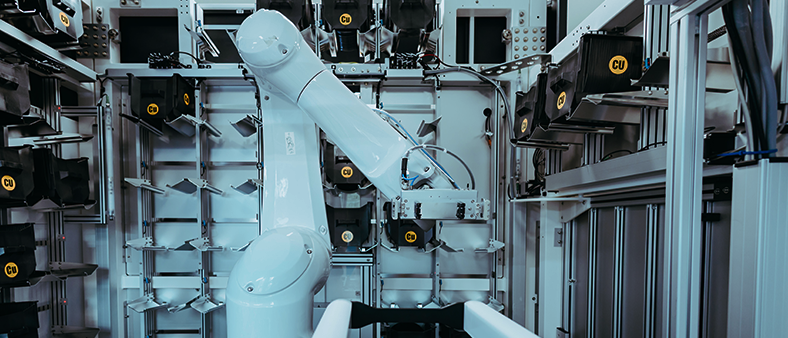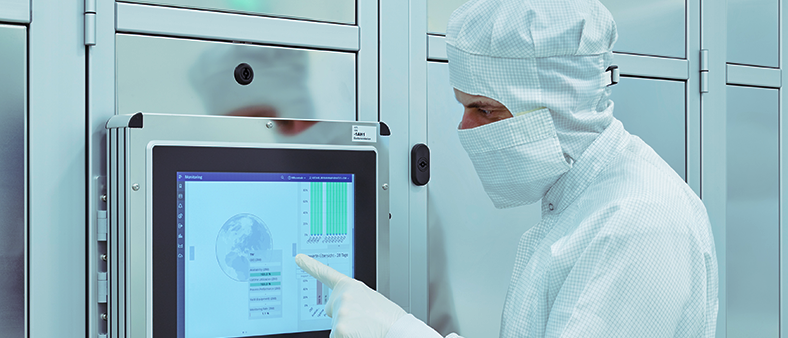
Fabmatics is your one-stop partner for legacy fab automation. With decades of experience and a comprehensive product portfolio, we help semiconductor manufacturers modernize 150 and 200mm fabs efficiently and sustainably.
From Legacy to Leverage - Why 200mm Fabs Are Gaining New Momentum
200mm fabs are far from outdated - they are proven, stable, and highly adaptable. In fact, many of today’s most critical applications rely on mature process technologies. Whether it’s analog, power, MEMS, or automotive chips, legacy fabs continue to deliver value.
What’s changing is the environment: rising labor costs, talent shortages, and the need for greater flexibility are prompting fab operators to rethink how they run their facilities.
Stay Competitive. Automate!
Automation offers a smart, low-risk way to extend fab lifetime, reduce cost per wafer, and stay competitive without the pressure of greenfield investments.
Your Challenges Are Our Daily Business
Smart Automated Material Handling System (AMHS) Automation for Legacy Fabs
Legacy fabs require tailored solutions - there’s no one-size-fits-all approach. Automation must deliver measurable benefits and be rolled out in phases, always aligned with a long-term vision for full build-out, full load, and high product mix. In some cases, partial or no automation may be the most cost-effective choice.
Fabmatics brings vast experience in implementing AMHS solutions in brownfield environments and during full production. We help customers define their long-term vision for automation and translate it into a practical roadmap driven by ROI and focused on reducing wafer cost.
External ContentPlease accept "External Media" cookies to see the content.
I accept the display of external media and the transfer and processing of personal data according to the privacy policy.
Please accept "External Media" cookies to see the content.
I accept the display of external media and the transfer and processing of personal data according to the privacy policy.
Challenge Meets Solution
Legacy fabs face unique automation challenges. Let's explore how typical obstacles can be transformed into strategic starting points.
Typical Automation Challenges our Customers face in Legacy Fabs
"We don’t know where to start with automation, and lack the digital infrastructure to begin"
Many golden fabs lack the digital infrastructure to begin automation. Fabmatics helps you take the first step with on-site analysis, fab assessments, and feasibility studies. By implementing RFID-based material identification and tracking, we lay the groundwork for scalable automation and paperless production.
"We don’t have the people to drive automation forward"
Many fabs lack the internal capacity or know-how to launch automation initiatives. As your one-stop partner, Fabmatics takes ownership of your automation journey - from concept to commissioning - so your team doesn’t have to. Our experts handle planning, integration, and service, allowing you to focus on your core operations.
"We only have limited space, and our fab layout has historically grown over decades"
Legacy fabs often suffer from space constraints and non-linear layouts. Our modular systems such as ceiling-based or greyroom-suitable stockers , conveyors and mobile robots are designed for confined, historically grown layouts. Fabmatics brings automation where others hit physical and technical limits.
"We’re working with non-standard equipment, and too many tools simply can’t be automated"
No two legacy fabs are alike - and neither are their tools and equipment. Fabmatics develops custom solutions for non-standard or seemingly non-automatable tools. From robot cells to intelligent material flow systems, we integrate seamlessly into your existing environment and close the gaps others leave behind.
"We’re missing proof that automation will pay off"
We understand that every investment needs justification. That’s why we offer ROI modeling based on your fab’s real data - including wafer moves, error rates, and shift patterns. Combined with simulations and proof-of-concept pilots, we help you identify the most impactful areas and build a solid business case for automation.
"We struggle to integrate new automation solutions into our existing software landscape"
Legacy IT environments are often fragmented and difficult to extend (island solutions, mixed generation software). Fabmatics provides a flexible software framework that integrates with your existing MES and tool interfaces (e.g. SECS/GEM, HSMS). This enables real-time data exchange, centralized control, and future-proof scalability without disrupting your current operations.
Our Portfolio
Fabmatics is your one-stop-partner supporting you from concept to full production.
IDENTIFICATION
RFID SYSTEMS
RFID RETROFITTING
TRANSPORT
CONVEYOR SYSTEMS
AGV's / RGV's
PGV's
HANDLING
MOBILE ROBOTS
EFEMs
ROBOTIC CELLS
STORAGE
ZERO FOOTPRINT
STOCKER
RFID RACKS
PROTECTION
PURGE SYSTEMS
YOUR ONE STOP SOLUTION
COMPLETE MATERIAL HANDLING AUTOMATION
CONSULTING
ASSESSMENT
FEASABILITY STUDIES
SIMULATION
SIMULATION
3D MATERIAL FLOW
SIMULATION
DIGITAL TWIN
SOFTWARE
FLEET MANAGER
INTEGRATION
SERVICE
TECHNICAL SERVICES
THIRD PARTY SUPPORT
We understand the complexity of legacy fabs and we know how to solve it
Our field-proven solutions are designed to work within your constraints, not against them.

Start Smart: Build Your Digital Foundation First
Fabmatics helps you take the first step even without existing infrastructure. Through on-site analysis, fab assessments, and feasibility studies, we define a clear automation roadmap. With RFID-based material identification and tracking, we lay the groundwork for scalable automation and paperless production.

Automation Without Overburdening Your Team
Many fabs lack the internal capacity or know-how to launch automation initiatives. As your one-stop partner, Fabmatics takes ownership of your automation journey - from concept to commissioning - so your team doesn’t have to. Our experts handle planning, integration, and service, allowing you to focus on your core operations.

Space-Savvy Solutions for Complex Layouts
Our modular systems such as ceiling-based or greyroom-suitable stockers , conveyors and mobile robots are designed for confined, historically grown layouts. Fabmatics brings automation where others hit limits.

Tailored Automation for Unique Toolsets
No two legacy fabs are alike. Fabmatics develops custom solutions for non-standard or seemingly non-automatable tools – from robot cells to intelligent material flow - and integrates them seamlessly into your existing environment.

Proven ROI Through Phased Automation
Customers achieve up to 30% shorter cycle times and higher WIP turns through targeted automation. With simulations, ROI modeling based on your fab’s real data and proof-of-concept, we show you upfront where automation truly pays off.

Seamless Integration into Your Software Landscape
We understand the complexity of legacy IT environments (island solutions, mixed generation software). Our software franework integrates smoothly with MES platforms and tool interfaces (e.g. SECS/GEM, HSMS), enabling real-time data exchange and centralized automation control without disrupting your operations.
FAQ - Technical Insights into Legacy Fab Automation
Is it technically feasible to automate a legacy fab during live production?
Yes. Fabmatics specializes in retrofitting automation into live production environments or as we call it: “open heart surgeries”. Our modular solutions and phased implementation strategies allow upgrades with minimal disruption, even with limited ceiling height, narrow aisles, and mixed equipment generations.
What are the most automation-ready areas in a 200mm fab?
Typical candidates include:
- Lot identification and tracking (RFID)
- Intrabay and interbay transport (AGVs, conveyors)
- Tool loading/unloading (robot cells, CoBots, load ports)
- Storage optimization (floor- or ceiling-based stockers)
- Test wafer management (kitting, dekitting and storage)
How does automation impact fab KPIs like cycle time and WIP turns?
As a rule of thumb, automation can reduce cycle time by 10 - 30%, with an additional 5 - 10% improvement through advanced scheduling. WIP turns increase from 3 - 4 (manual fabs) to 5 - 6 with AMHS.
What are the key technical constraints when retrofitting automation?
- Ceiling height and structural load capacity
- Floor tile quality and layout geometry
- Carrier types (open cassette, SMIF pod, FOUP)
- Equipment automation readiness (load port interfaces)
- Existing MES/CIM infrastructure compatibility
What’s the ROI potential of automation in legacy fabs?
Return on Investment (ROI) depends on fab layout, throughput, and labor intensity. Fabmatics offers a data-driven ROI model that calculates savings based on your fab’s real data - including wafer moves, shift patterns, error rates, and energy consumption. This helps you make informed decisions and identify high-impact areas for automation.
Can automation help with the skilled labor shortage?
Absolutely. Automated lot tracking, transport, and tool loading reduces dependency on manual labor, minimizes human error, and enables 24/7 operation. It also helps preserve process knowledge by embedding it into systems rather than relying solely on personnel.
How long does a typical automation project take?
Timelines vary depending on scope and fab complexity. A phased approach allows for quick wins in high-impact areas, with full rollout typically spanning several months. We support you from assessment and feasibility study to commissioning and beyond.
Contact our Experts
Let’s build your automation business case – Fabmatics supports you from simulation to system rollout.

Rico Thieme
Director Sales and Business Development (Europe)
Fabmatics GmbH

Have a question? We’re here to help.
From RFID to Full Automation
Every journey toward an efficient and automated production begins with a first step – and in semiconductor manufacturing, that step is reliable digital identification. Fabmatics delivers smart identification solutions that scale with your fab.
